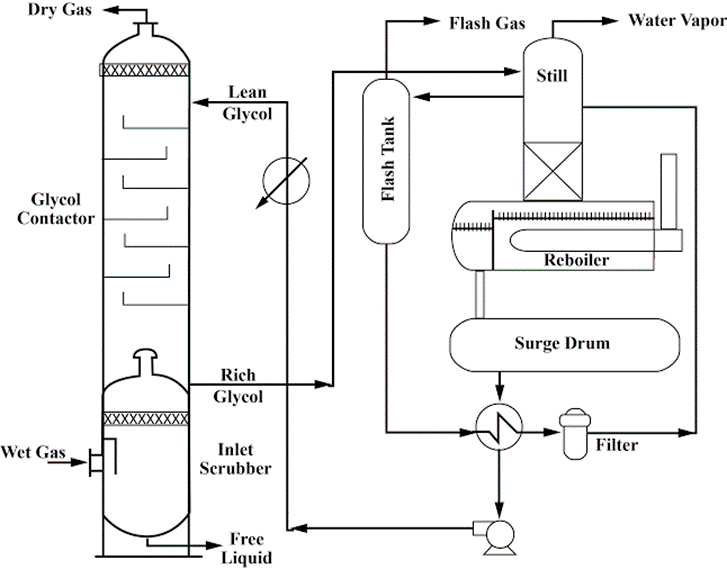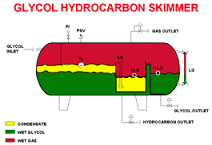| |
|
»
TEG
Gas Dehydration:
TEG Gas
Absorber Tower and TEG Regeneration Unit

The gas flows through a separator to remove
condensed liquids or any solids that might be in the gas. Some absorbers incorporate the separator in a
bottom section of the vessel, in which case the gas
then flows upward through a chimney tray into the
glycol absorber portion of the vessel. The glycol
contactor or absorber can contain:
- Trays
- Structured packing
If it is a trayed vessel, it will contain several
bubble-cap trays. Lean glycol is pumped into the
upper portion of the contactor, above the top tray
but below the mist eliminator. The trays are flooded
with glycol that flows down from tray to tray in
downcomer sections. The gas rises through the bubble
caps and is dispersed as bubbles through the glycol
on the trays. This provides the intimate contact
between the gas and the glycol. The glycol is highly
hygroscopic, and most of the water vapor in the gas
is absorbed by the glycol. The rich glycol,
containing the absorbed water, is withdrawn from the
contactor near the bottom of the vessel above the
chimney tray through a liquid level control valve
and passes to the regeneration section. The treated
gas leaves the contactor at the top through a mist
eliminator and usually meets the specified water
content.
The rich glycol can be routed through a heat
exchange coil in the top of the reboiler column
called the still. The heat exchange generates some
reflux for the separation of the water from the
glycol in the top of the still and also heats the
rich glycol somewhat. In some installations, the
rich solution passes to a flash tank operating at
about 15 to 50 psig, which allows absorbed
hydrocarbon gas to separate from the glycol. The
glycol then flows into the still through a filter
and a heat exchanger, exchanging heat with the
regenerated glycol. It drops through a packed
section in the still into the glycol reboiler
vessel, where it is heated to the necessary high
regeneration temperature at near atmospheric
pressure. At the high temperature, the glycol loses
its ability to hold water; the water is vaporized
and leaves through the top of the still. The
regenerated glycol flows to the surge tank, from
which it is routed through the lean/rich heat
exchanger to the glycol pump. The pump boosts the
pressure of the lean glycol to the contactor
pressure. Prior to entering the contactor, it
exchanges heat with the dry gas leaving the
contactor or some other heat exchange medium.

Glycol
Regeneration Unit.
 |